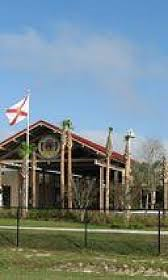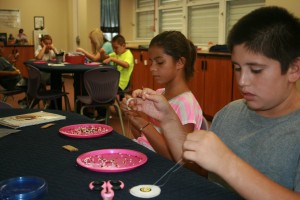
The Pemayetv Emahakv, a K-8 charter school in Florida, teaches students the Seminole Indian reservation's native Creek language and culture.
Enter Central Florida’s Brighton Indian Reservation, past cattle fields and citrus groves, and it doesn’t take long to understand the priorities of this Florida Seminole Indian Tribe.
There’s a casino, but there’s also a new elder affairs building and a star-shaped veterans center ringed with giant bronze statues. And there’s a charter school that’s become the community’s heartbeat.
Inside Pemayetv Emahakv, which means “Our Way,’’ students in kindergarten through eighth grade straddle two worlds – one rooted in their rich, proud heritage; the other in the wider space where they must compete and succeed like their counterparts across the planet.
So they study Creek, the tribe’s native tongue, along with the state’s new science standards. They string Indian beads into necklaces and read books on Kindles. They cook fry bread in chickees and take standardized tests in state-of-the art classrooms.

Students, most of whom are from the Seminole Indian Tribe, learn to string beads into jewelry the same way their ancestors did.
“We wanted a native curriculum,’’ said Michele Thomas, a parent and administrative assistant at the school and a Florida Seminole Indian. “That was the sole purpose. This school was built to save our language.’’
It’s no accident the school is a charter. That’s what gave it the flexibility to offer deep immersion in Seminole culture. It’s no surprise, either, that it’s part of a growing trend of charter schools opening on American Indian reservations across the country.
There are now 31 of them, according to a recent report by the National Alliance for Public Charter Schools. Twelve opened on Bureau of Indian Affairs lands between 2005 and 2010.
Some of the increase is due to a decades-old Congressional moratorium on new schools operated by the federal Bureau of Indian Education, which oversees public schools on American Indian reservations. That meant tribes couldn’t expand existing ones, either.
Charters offered an option.
But much of the growth can be attributed to a desire by American Indians to preserve their fading culture.
“When we were growing up, our grandmas were around,’’ said Cecelia Thomas, a Seminole tribal member and bookkeeper at the school where two of her children attended. “Our uncles were around. Our mom and dad were around. We all lived on the same street or in the same little house. We just seemed to be a tighter-knit family.’’
Customs and language were passed down, from generation to generation. But even Thomas, 45, has lost some of those connections. Like a lot of parents her age on the reservation, she can’t speak her native tongue fluently so she can’t teach it to her children.
Before the charter school, she said, “our language was dying.”
Some charter schools aim to save kids. Some aim to save cultures – and the kids along with it.
A new report from Harvard education researchers highlights three charter schools that offer cultural immersion for Native American students, including a K-8 charter on a Seminole Indian reservation in Glades County, Fla. The school’s name, Pamayetv Emahakv, means “our way,” which sums up the school’s goal: Preparing more than 200 students for the higher education they’ll need to succeed anywhere in the 21st century while at the same time holding on to Seminole culture and values.
“We turned our back on our way to go and learn the other way,” Michele Thomas, a school administrator and parent, told the researchers when they visited earlier this year. “So, now with this school we have to look back this way now. We have the education down, we have lots of college education in this community, but our language has suffered, our young people are not fluent speakers.”
Some education researchers think the approach of the Seminole charter and the two others in the report could help Native American students elsewhere who are not faring well in traditional public schools. According to the report, which was prepared for the National Indian Education Association, American Indian students have the highest absentee rate among minority students and the second-highest suspension and dropout rates.
“These three schools … all share a broader vision of transformative community change,” wrote the Harvard researchers, Eve L. Ewing and Meaghan E. Ferrick. “The establishment of a school serves as a means for mobilizing and empowering the local communities to assess their own needs and determine their own solutions. By doing so, community members not only improve educational outcomes for their children – they are also making a profound expression of self-determination and tribal sovereignty.”
The motto of the Seminole school boldly echoes that: “Successful learners today, unconquered leaders tomorrow.” (The Seminoles call themselves “the unconquered” because even after three wars with the federal government, over half a century, they never surrendered.)
The charters in the Harvard report are part of a national movement by Indian and other native communities to use charter schools to help resurrect and maintain their indigenous cultures. (more…)